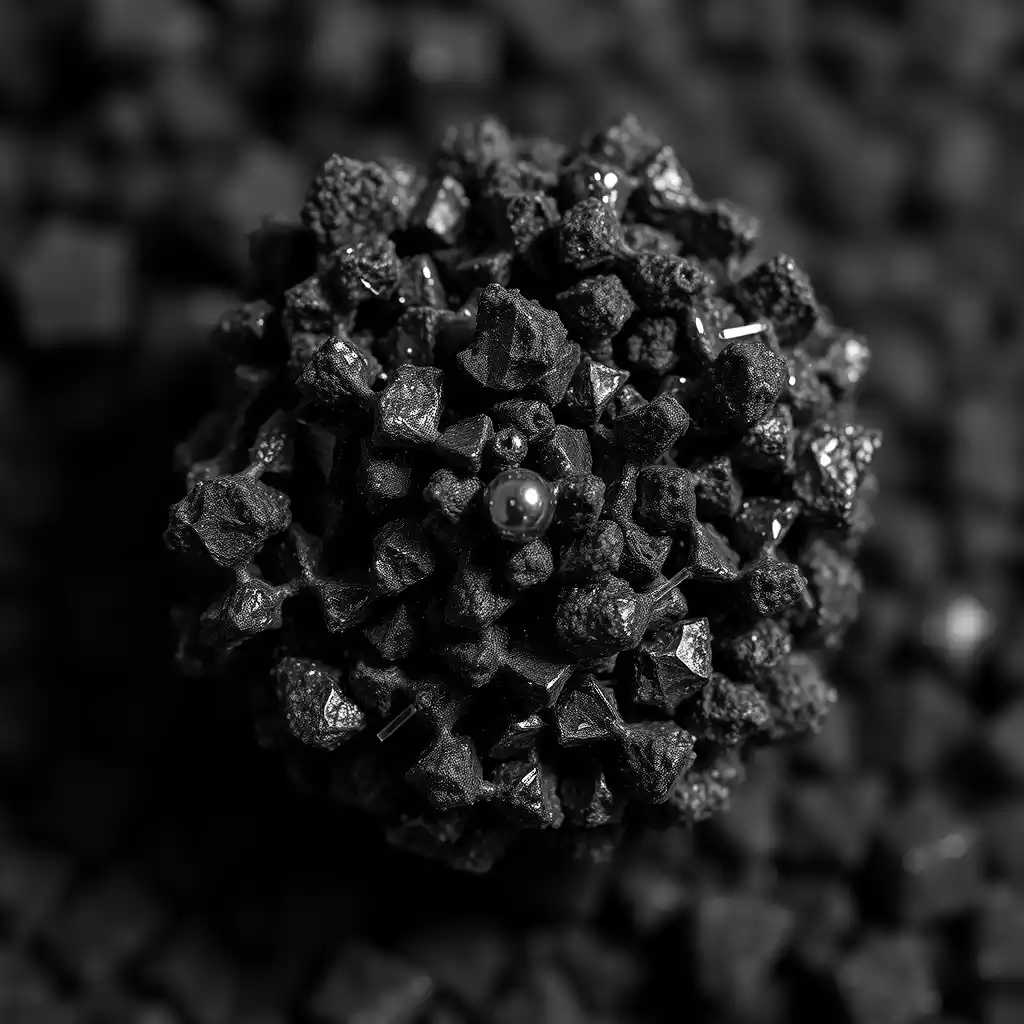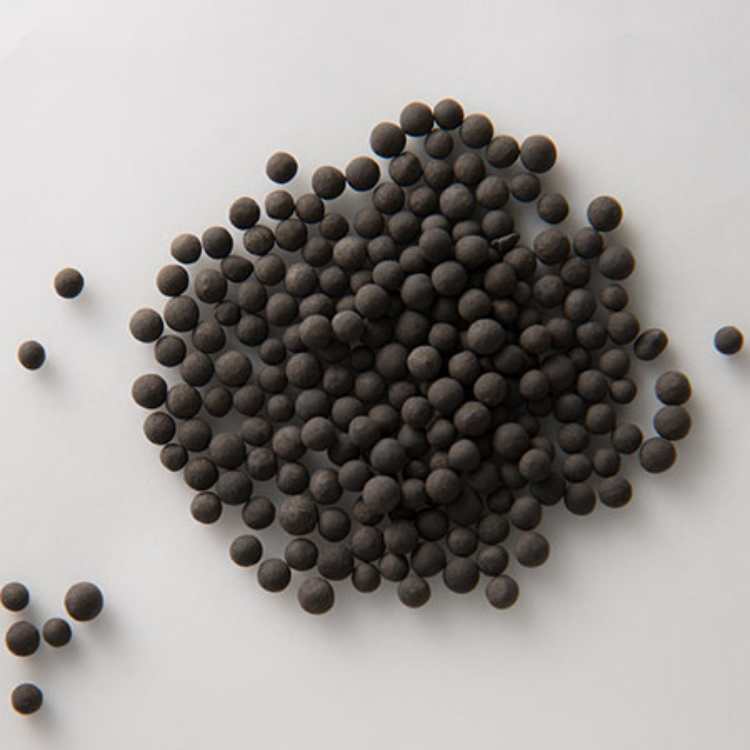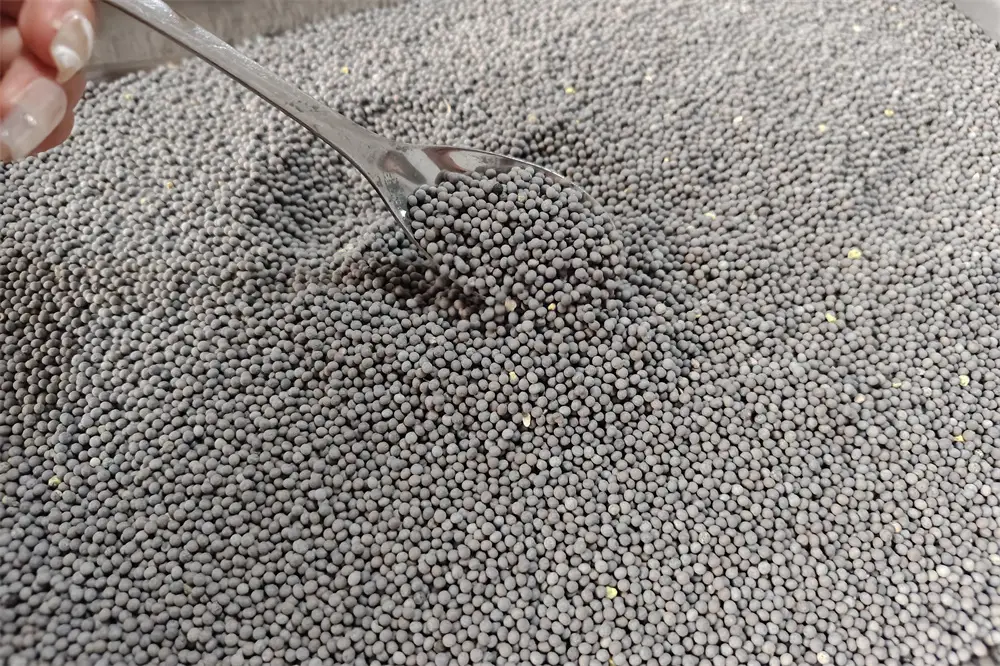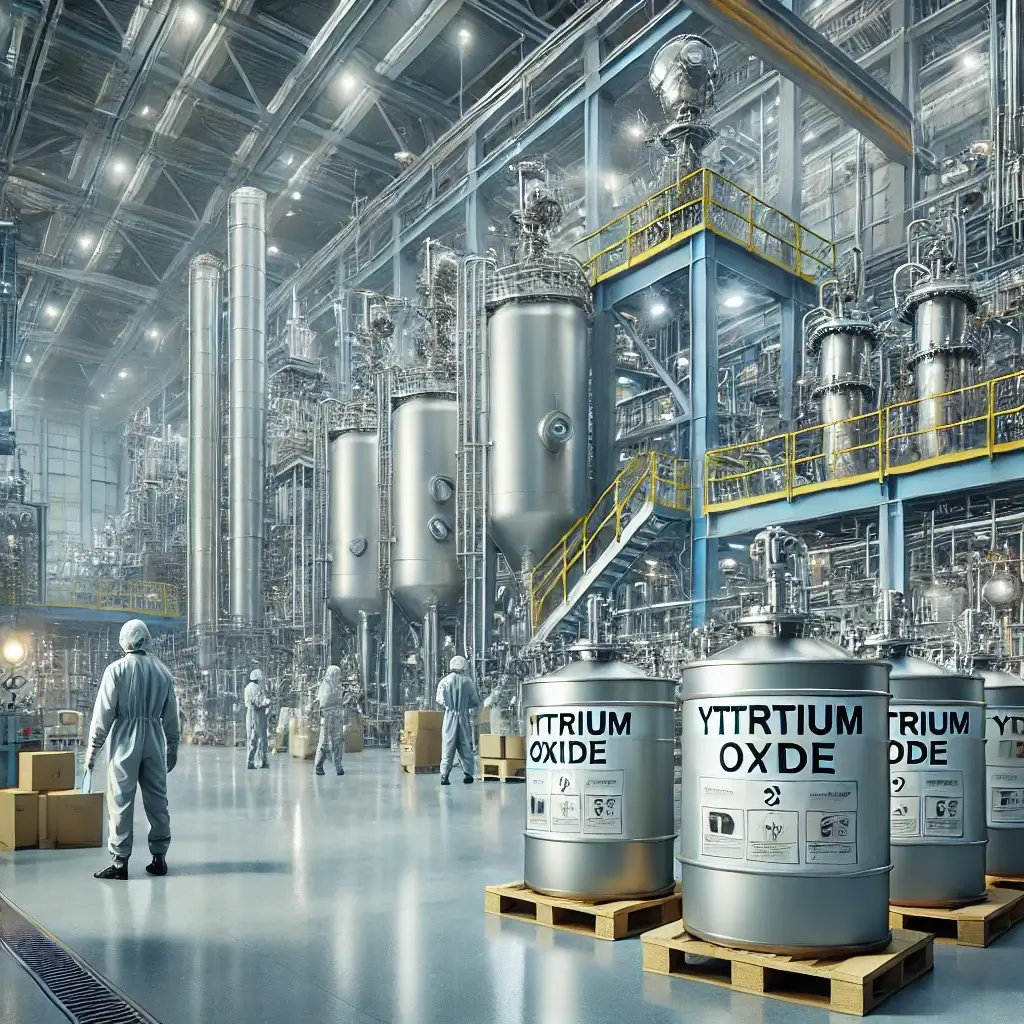![]()

¿Qué es el catalizador de carbono-paladio?
El catalizador de paladio y carbono El paladio es un catalizador de alta eficiencia que se utiliza en diversos procesos químicos, como la hidrogenación, la deshidrogenación y la síntesis de productos químicos finos. Pero, ¿qué es exactamente el catalizador de paladio sobre carbono y cómo funciona? Para comprender su importancia en la industria moderna, primero debemos examinar sus componentes, sus aplicaciones y por qué es tan buscado por los fabricantes de productos químicos de todo el mundo.
La composición del catalizador de paladio y carbono
En su nivel más básico, el catalizador de carbono y paladio es un material compuesto formado por dos componentes principales:
- Paladio (Pd):El paladio es un metal precioso que resulta muy eficaz como catalizador debido a su capacidad para activar las moléculas de hidrógeno y facilitar las reacciones químicas. Tiene la capacidad única de absorber hidrógeno y otros gases, lo que lo hace ideal para la hidrogenación y otros procesos catalíticos.
- Carbón activado:El carbón utilizado en el catalizador se deriva normalmente de materiales como cáscaras de coco, madera o turba. El carbón activado es poroso, lo que le otorga una enorme superficie. Esto permite que el metal paladio se disperse por la superficie del carbón, creando más sitios activos para que se produzcan reacciones.
Cuando se combinan estos dos materiales, los catalizadores de carbono y paladio se vuelven increíblemente eficientes para promover una amplia variedad de reacciones químicas.
¿Qué hace que los catalizadores de carbono y paladio sean tan efectivos?
La alta eficiencia de los catalizadores de paladio y carbón se debe a las propiedades combinadas del paladio y el carbón activado. A continuación, se detallan sus principales ventajas:
1. Gran superficie
El carbón activado proporciona una gran superficie sobre la que se puede depositar el metal paladio. Esta mayor superficie permite que más moléculas entren en contacto con el paladio, lo que mejora la eficiencia general de la reacción. Por ejemplo, la superficie de los catalizadores de carbón de paladio puede superar 930 m²/g, que es significativamente más grande que muchos otros catalizadores.
2. Alta actividad del paladio
El paladio es conocido por su capacidad para catalizar reacciones de hidrogenación. Cuando se lo soporta sobre carbón activado, permanece muy activo en estas reacciones. Esto hace que los catalizadores de carbón de paladio sean extremadamente valiosos en industrias donde la hidrogenación es un proceso común, como en las industrias alimentaria y farmacéutica.
3. Rentabilidad
En comparación con otros catalizadores que requieren metales raros o costosos, los catalizadores de paladio y carbón ofrecen una opción más rentable sin sacrificar el rendimiento. El paladio es un metal precioso, pero sigue siendo más asequible cuando se utiliza en combinación con carbón activado en comparación con los catalizadores de paladio puro.
4. Longevidad y reutilización
Los catalizadores de paladio al carbono se pueden reutilizar varias veces. Después de una reacción catalítica, el catalizador se puede recuperar y regenerar, lo que lo convierte en una opción sostenible para muchas industrias. La capacidad de reutilizar el catalizador ayuda a reducir el costo general de producción.
Aplicaciones del catalizador de paladio y carbono
Los catalizadores de paladio y carbono se utilizan en una amplia gama de industrias debido a su versatilidad y eficacia. Algunas de las aplicaciones más comunes incluyen:
1. Reacciones de hidrogenación
Uno de los principales usos de los catalizadores de paladio sobre carbono es en las reacciones de hidrogenación. Se trata de reacciones químicas en las que se añaden moléculas de hidrógeno a compuestos orgánicos insaturados, como alquenos o alquinos, para convertirlos en compuestos saturados. Esto se utiliza habitualmente en la industria alimentaria para la hidrogenación de aceites para elaborar margarina y otros productos alimenticios.
Por ejemplo, en la hidrogenación de aceites vegetalesEl carbono de paladio se utiliza a menudo como catalizador para convertir grasas insaturadas en grasas sólidas, mejorando así la vida útil y la estabilidad del producto.
2. Reacciones de deshidrogenación
Además de la hidrogenación, los catalizadores de paladio sobre carbono también se utilizan en reacciones de deshidrogenaciónEste proceso implica la eliminación de hidrógeno de compuestos orgánicos para crear productos insaturados. La deshidrogenación es fundamental en la producción de sustancias químicas como etileno, que es un componente clave en la producción de plásticos, anticongelantes y otros productos químicos.
3. Síntesis química fina
Los catalizadores de paladio y carbono se utilizan ampliamente en la síntesis de productos químicos finos, especialmente en las industrias farmacéutica y agroquímica. Por ejemplo, se utilizan en la producción de intermedios farmacéuticos, donde la capacidad del paladio para facilitar la hidrogenación selectiva es esencial para sintetizar moléculas orgánicas complejas.
4. Industria petroquímica
En el Industria petroquímicaLos catalizadores de paladio y carbono se utilizan para mejorar la eficiencia de los procesos de refinación. El catalizador se utiliza para eliminar componentes no deseados de los productos derivados del petróleo, como el azufre, mejorando así la calidad de los combustibles como la gasolina y el diésel.
5. Recuperación de metales preciosos
Los catalizadores de paladio y carbono también se utilizan en la recuperación de metales preciosos, en particular en aplicaciones en las que se extraen paladio u otros metales valiosos de desechos industriales o productos desechados. El catalizador ayuda a facilitar la eliminación y purificación de estos metales, que luego se reutilizan en otras aplicaciones.

¿Cómo funciona el catalizador de carbono-paladio?
El principio de funcionamiento de los catalizadores de paladio y carbono se basa en la capacidad del paladio de actuar como un sitio activo para las reacciones químicas. El mecanismo implica varios pasos:
- Adsorción de reactivos:Los reactivos, como el gas hidrógeno o los compuestos orgánicos, se adsorben en la superficie del catalizador. El carbón activado proporciona la superficie, mientras que los átomos de paladio actúan como sitios activos para las reacciones químicas.
- Activación de reactivos:El paladio facilita la ruptura de enlaces en los reactivos, como los enlaces de hidrógeno en los hidrocarburos insaturados. Esta activación es lo que hace que se produzcan las reacciones químicas.
- Finalización de la reacción:Una vez rotos los enlaces y completada la reacción, los productos se liberan de la superficie del catalizador.
- Regeneración:En muchos casos, los catalizadores de paladio sobre carbono se pueden regenerar, lo que permite reutilizarlos en múltiples ciclos de reacción. Este proceso regenerativo mejora aún más su eficiencia y rentabilidad.
El mercado mundial de catalizadores de paladio y carbono
Los catalizadores de carbono y paladio tienen una gran demanda en todo el mundo, particularmente en regiones como Europa, América del norte, Corea del Sur, Japón, y RusiaEstas regiones tienen una fuerte presencia industrial, con una demanda significativa de catalizadores de carbono de paladio en sectores como productos farmacéuticos, automotor, petroquímicos, y procesamiento de alimentos.
El mercado mundial de catalizadores de paladio al carbono se ha expandido de manera constante debido a su amplia gama de aplicaciones. A medida que las industrias se esfuerzan por lograr procesos de producción más eficientes y sostenibles, se espera que la demanda de catalizadores de paladio al carbono siga aumentando.
Principales beneficios del uso de catalizador de paladio y carbono
1. Mayor eficiencia de reacción
Los catalizadores de paladio y carbono mejoran la eficiencia de las reacciones químicas, reduciendo la cantidad de energía necesaria para completar una reacción y aumentando el rendimiento general del producto deseado. Esto es particularmente importante en industrias donde la alta pureza del producto y el bajo consumo de energía son cruciales.
2. Solución rentable
Si bien el paladio es un metal precioso, su uso en combinación con carbón activado reduce significativamente el costo total del catalizador. Esto hace que los catalizadores de carbón y paladio sean una solución asequible para muchas industrias y ofrecen un gran valor en comparación con otras opciones catalíticas.
3. Reducción del impacto ambiental
Los catalizadores de paladio y carbono contribuyen a que los procesos de producción sean más ecológicos al promover reacciones más eficientes que reducen los desechos y los subproductos. Esto los convierte en una opción ecológica para las industrias que priorizan la sostenibilidad.
4. Versatilidad en diferentes industrias
La versatilidad de los catalizadores de paladio al carbono los hace adecuados para una amplia variedad de aplicaciones industriales. Ya sea que se utilicen en hidrogenación de aceites, el síntesis de productos químicos finos, o el recuperación de metales preciososLos catalizadores de paladio y carbono ofrecen una solución única para muchos procesos químicos.
Conclusión: ¿Por qué elegir el catalizador de carbono y paladio?
Los catalizadores de paladio y carbón se encuentran entre los catalizadores más eficaces y versátiles que se utilizan en la industria moderna. Su capacidad para facilitar una amplia gama de reacciones químicas, desde la hidrogenación hasta la síntesis química fina, los ha hecho indispensables en diversos sectores. Al combinar la alta actividad del paladio con la naturaleza porosa del carbón activado, estos catalizadores ofrecen una eficiencia, una rentabilidad y una sostenibilidad inigualables. A medida que las industrias siguen buscando formas de mejorar sus procesos, los catalizadores de paladio y carbón seguirán siendo un actor clave en la configuración del futuro de la fabricación de productos químicos.
Ya sea que estés en el farmacéutico, automotor, petroquímico, o procesamiento de alimentos En la industria, los catalizadores de paladio y carbono ofrecen una solución confiable para mejorar sus procesos químicos. Su alta reactividad, larga vida útil y naturaleza rentable los convierten en la opción preferida de muchas empresas en todo el mundo.
Comuníquese con Honrel para sus necesidades de catalizador de carbono y paladio
Si está interesado en obtener más información sobre nuestros catalizador de paladio y carbono o cualquier otro Materias primas químicasNo dudes en contactarnos. HonrelProporcionamos catalizadores de primera calidad y una amplia gama de materias primas industriales a empresas de todo el mundo. Nuestro equipo está preparado para ayudarle con sus necesidades específicas y elegir los productos adecuados para sus procesos.
Siéntete libre de Contacta con Honrel Contáctenos hoy para analizar sus necesidades y recibir recomendaciones personalizadas. Nos comprometemos a brindarle las mejores soluciones a precios competitivos.




